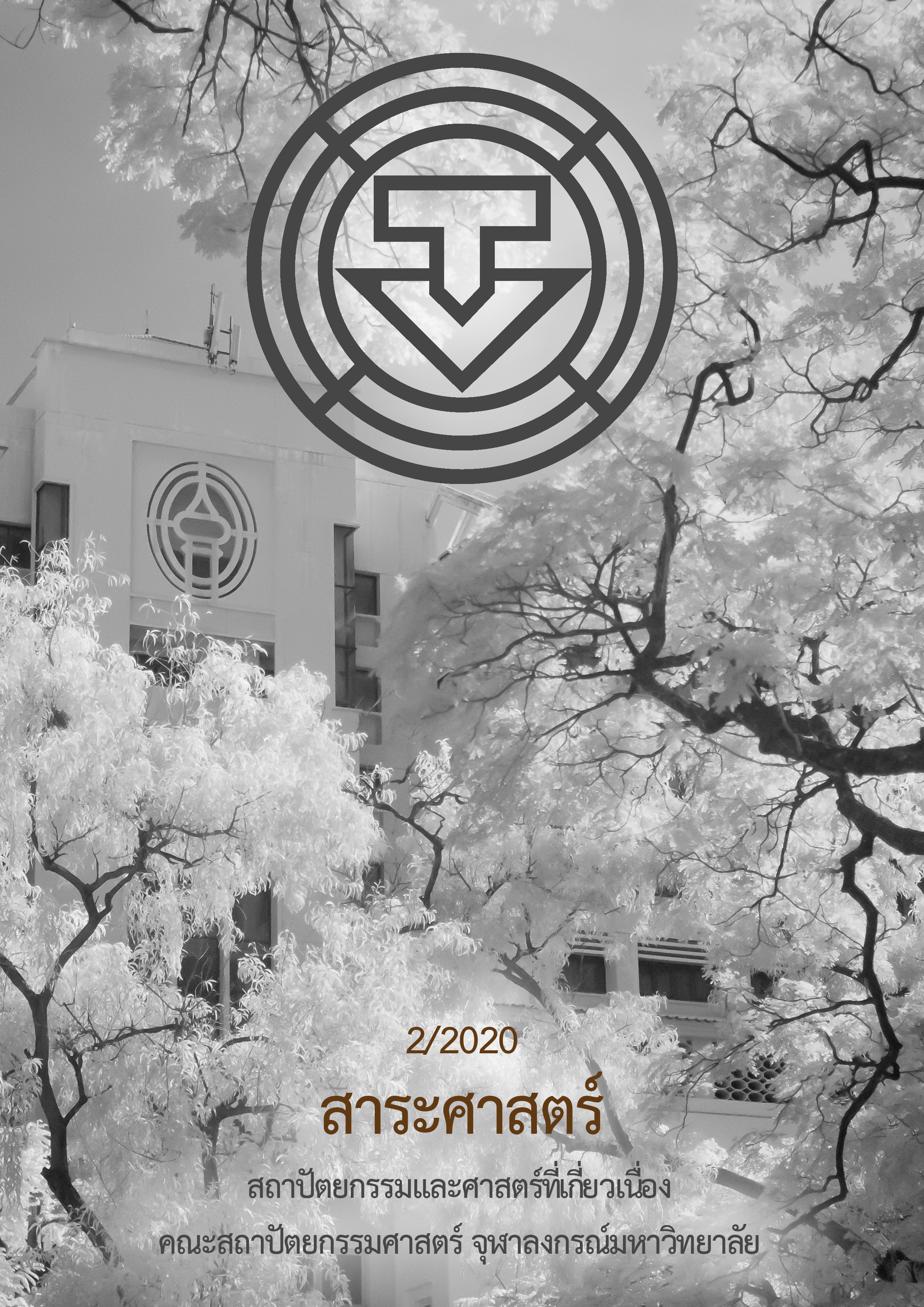การเปรียบเทียบต้นทุนและผลตอบแทนโครงการจัดสรรในประเทศไทยโดยการใช้ เบอร์โทด์โมเดล: กรณีศึกษา หมู่บ้านจัดสรรในอำเภอธัญบุรี จังหวัดปทุมธานี
Main Article Content
บทคัดย่อ
เบอร์โทด์โมเดล (Bertaud Model) ถูกสร้างขึ้นมาเพื่อใช้ทดสอบความเป็นไปได้ในการพัฒนาโครงการอสังหาริมทรัพย์ในแนวราบ และเพื่อให้ทำการวิเคราะห์ความเป็นไปได้เบื้องต้นของโครงการ (Pre-feasibility study) มีความรวดเร็วและครบถ้วนทั้งในด้านกายภาพและด้านการเงิน เพื่อสร้างความเข้าใจที่ตรงกันของผู้มีส่วนร่วมในอาชีพที่เกี่ยวข้องกับการพัฒนาโครงการที่อยู่อาศัยและอสังหาริมทรัพย์แนวราบ สามารถใช้คำนวณต้นทุน และผลตอบแทนจากการออกแบบวางผังโครงการ ซึ่งใช้ได้ทั้งก่อนการทำงานและควบคู่ไปกับการออกแบบวางผัง จึงมีประโยชน์มากในการพัฒนาโครงการหมู่บ้านจัดสรร
จากการศึกษารูปแบบการออกแบบวางผังโครงการหมู่บ้านจัดสรร พบว่ามีรูปแบบที่หลากหลายตามบริบทของพื้นที่โครงการรวมถึงวัตถุประสงค์ของผู้พัฒนา ซึ่งจะเป็นสิ่งที่กำหนดสัดส่วนพื้นที่ขาย ต้นทุน และผลตอบแทน ไปจนถึงคุณภาพการอยู่อาศัย บทความนี้จึงมีวัตถุประสงค์เพื่อวิเคราะห์เปรียบเทียบรูปแบบการวางผังโครงการจัดสรรในพื้นที่กรณีศึกษา อำเภอธัญบุรี จังหวัดปทุมธานี 5 รูปแบบ ตามลักษณะการสัญจรภายในโครงการ คือ แบบเชิงเส้น (Linear) แบบตาราง (Grid) แบบวง (Loop) แบบถนนปลายตัน (Cul-de-sac) และแบบผสม (Multi-Layout) พร้อมทั้งวิเคราะห์เปรียบเทียบการใช้พื้นที่ในการวางผังแต่ละรูปแบบกับต้นทุนและผลตอบแทนจากสัดส่วนการใช้พื้นที่นั้น ๆ โดยใช้แบบจำลองการคำนวณ เบอร์โทด์โมเดล (Bertaud Model) เป็นเครื่องมือในการวิเคราะห์
ผลการศึกษาชี้ให้เห็นว่าขนาดที่ดิน รูปร่างที่ดิน และรูปแบบของการวางผังที่แตกต่างกัน ส่งผลให้การใช้พื้นที่ ประกอบไปด้วยพื้นที่ขายได้และพื้นที่ขายไม่ได้ ต้นทุน และผลตอบแทนต่างกัน โดยจากกรณีศึกษา พบว่า การวางผังแบบผสม(Multi-Layout) เป็นรูปแบบการวางผังที่ทำให้เกิดอัตราผลตอบแทน (IRR) สูงที่สุดจากการเปรียบเทียบในแต่ละรูปแบบ โดยปัจจัยหลักมี 2 ส่วน ประการแรกคือต้นทุนที่ต่ำกว่าเมื่อเทียบกับราคาค่าที่ดินที่พัฒนาแล้ว ประการที่สองคือมีสัดส่วนการใช้ที่ดินและมีการออกแบบวางผัง โดยมีการแบ่งพื้นที่สีเขียวและนันทนาการในสัดส่วนที่มากกว่ารูปแบบอื่น ผู้พัฒนาโครงการจึงสามารถเพิ่มมูลค่าราคาขายได้ โดยผลที่ได้จะนำมาสู่ข้อเสนอแนะในการวางผังโครงการจัดสรรต่อไป
Article Details
เอกสารอ้างอิง
ชูศักดิ์ ศรีอนุชิต. “พระราชบัญญัติจัดสรรที่ดิน.” สืบค้น 5 พฤษภาคม 2562. http://constructionthaicon.wordpress.com/2009/03/25/searchforearth6.
เดชา บุญค้ำ. การวางผังบริเวณและงานบริเวณ. พิมพ์ครั้งที่ 1. กรุงเทพฯ: สำนักพิมพ์แห่งจุฬาลงกรณ์มหาวิทยาลัย, 2552.
บีทวีนเมทส์. “ความแตกต่างระหว่าง IRR และ ROI.” สืบค้น 11 มิถุนายน 2563. https://th.betweenmates.com/difference-between-irr-and-roi-6349.
พลัส พร็อพเพอร์ตี้. “ปทุมธานี-ลำลูกกา ทำเลบ้านเดี่ยวครองใจคน.” สืบค้น 27 กันยายน 2562. https://www.plus.co.th/articles/PLUS-1128/ปทุมธานี-ลำลูกกา-ทำเลบ้านเดี่ยวครองใจคน.
ภาวิณี ธีรสวัสดิ์. สัมภาษณ์เรื่อง ความเป็นมาของ Bertaud Model โดย ภานินี ชยานันท์. 16 มิถุนายน 2562.
ศูนย์ข้อมูลอสังหาริมทรัพย์ ธนาคารอาคารสงเคราะห์. “สถานการณ์ตลาดที่อยู่อาศัยกรุงเทพฯ-ปริมณฑล ไตรมาส 1 ปี 2562.” สืบค้น 26 กันยายน 2562. Reic.or.th/Upload/สถานการณ์อสังหาริมทรัพย์ กทม.- ปริมณฑลไตรมาส 1 ปี 2562 -Edit_794_1561521818_64161.pdf.
Bertaud, A., M. A.,Bertaud, and James O. Wright, Jr. Efficiency in Land Use and Infrastructure Design An Application of the Bertaud Model. Washington, D.C.: Infrastructure and Urban Development Department, The World Bank Policy Planning and Research Staff, 1988.
Grammenos, Fanis and Julia Tasker-Brown. "Residential Street Pattern Design." Accessed September 12, 2019. www.irbnet.de/daten/iconda/CIB4226.pdf.
Pedro Ferraz de Abreu. A Two-Way Mirror on the Evolution of Information Technology’s Impact on Planning for Low-Income Housing. Cambridge: Department of Urban Studies and Planning, Massachusetts Institute of Technology, 1993.


